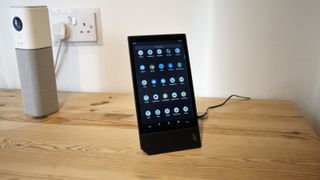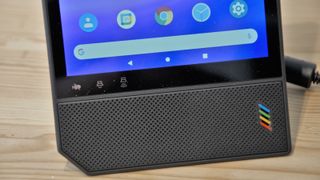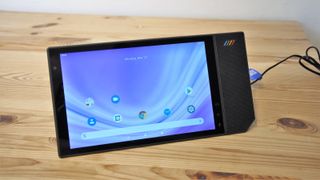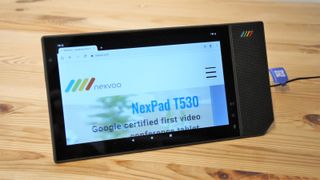TechRadar Verdict
As much as we liked the styling, the Nexpad Pro T530 is a low specification tablet without a battery. The concept of a tablet that can’t be borrowed makes sense, although the security side of Android is a concern.
Pros
- +
Android 10
- +
Easy to install and configure
- +
Excellent screen
Cons
- -
Expensive for the hardware specification
- -
No remote management tools
- -
Pre-installed Facebook
Why you can trust TechRadar
According to its LinkedIn page, Nexvoo is based in Indianapolis, and are a leading global brand for video-enhanced unified communications solutions including Phones, Video Conference Bars and Video-enhanced Large IFPs Panels.
The review hardware they sent to us is a hybrid design aimed at office use covering the functionality of several devices, potentially. Should the user not already have a computer and a phone.
When is a tablet not a tablet? It’s not a very Lewis Carol answer, but when it is a Nexvoo Nexpad Pro T530, and requires the main power to work.
Price and availability
The Nexvoo NEXPAD™ Pro T530, or T530 as we’ll call it from this point onwards, costs $399 directly from the makers.
It appears that there is only one model, simplifying any purchasing decisions.

Design
The design of this device strays from the well-worn path, since it is effectively an Android 10 tablet but without battery power.
If that sounds silly, and it might, then it’s worth considering that tablets along with phones are the items of technology that companies see disappear from their offices more than any other.
The T530 is meant to sit on a desk where it can provide access to basic email services, a digital assistant, conference calls and any other jobs that you might do with a tablet.
Except it is possible to chain this one to the furniture using a provided security slot, so it won’t magically go missing, never to be seen again.
As it isn’t meant to be carried around, the rear of the case is shaped to provide a stand that can place the T530 either horizontally or in a portrait aspect, and you can move between these if you find each has its uses.
For those that like larger displays, it has HDMI out, and the front-facing camera is good enough for 4K video on Skype, Zoom, or whatever meeting software is currently in vogue at work.
A microphone array picks up local voices, and internal speakers relay sound.

On the rear is an Ethernet port for wired networking, or the device can alternatively connect using WiFi. Without access to the network, the T530 is pointless, so you need one or the other.
Power comes from a small 2A power pack that came with three interchangeable power pins that cover the US, China and Europe, but not the UK. To solve that last issue, we used a converter, an additional cost that UK customers might need to budget for.
Other than being directly powered and an odd shape, the only other noticeable diversion from Android tablet norms is that on the border of the display are three touch buttons for muting sound and increasing or decreasing volume.
Nexvoo didn’t put a volume rocker on this hardware, and the only physical buttons are a power on/off, and a slider that covers the camera for guaranteed privacy.
In many respects, the outside of the T530 ask many questions about how it might be used, and to answer those requires experiencing its OS.

Hardware
Weight: 729g
Dimensions: 239 x 123 x 118 mm
Display size: 8.0-inch
Resolution: 1920 x 1200
Pixel density: 283 ppi
Chipset: Snapdragon 450
GPU: Adreno 506
RAM: 3GB
Storage: 21GB
Rear cameras: N/A
Front camera: 8MP
Battery: N/A
The tablet technology in the T530 came from parts designed for phones and tablets, mostly by Qualcomm. It’s the Qualcomm designed Snapdragon 450 that is at the heart of the SoC, combined with 3GB of LPDDR3 and 32GB of flash storage.
We assume 32GB, but the end-user reality is that they have access to just 21GB of that capacity, and in our system, that was reduced to 17.2GB by pre-installed applications.
As we delved inside the machine, a few curiosities emerged that hinted that the hardware inside may have been repurposed from a previous Nexvoo project.
This machine is labelled as the T530, but the device ID is N380, the name of another Nexvoo product, the Nexfone N380. That they share the same screen and electronics isn’t a huge surprise, but not bothering to change the ID does appear lax.
Undoubtedly the best bit of this device is the 1920 x 1200 resolution display that Nexvoo describe as ‘Retina-level’. Just for clarity, there is no definition of retina displays, but it infers that at a normal viewing distance the human eye wouldn’t easily be able to see individual pixels.
Apple came up with ‘retinal display’ marketing guff, and its current iPad Mini has a resolution of 2048 x 1536 on a 7-inch panel, making it 326 pixels per inch, and not the 283 ppi seen in this device. That said, this screen is sharp, bright and reasonably well saturated.

The rest of this hardware is much less impressive, starting with the eight-core Snapdragon 450. This SoC was designed for low power phone and tablets, making it specified in ways that aren’t relevant to a machine that doesn’t use batteries.
But then this machine also, because they come with the SoC, an accelerometer and gyroscope, also somewhat moot on a system that sits on a desk.
In Nexvoo’s defence, Qualcomm hasn’t addressed specifically the tablet-that-stays-put market with a special SoC, so this choice has more to do with cost and reliability that fitting the usage model perfectly.
This hardware might be at the bottom of the Android performance ladder, but it is sufficient to run the standard Google applications and provide reasonably responsive interaction with the user.
Camera
The T530 only has a forward-facing camera, based on the Sony IMX219 8MP sensor, the same hardware that appeared in the Raspberry Pi Camera Module V2.
As the machine can be orientated two ways, the placement on the camera on the top left corner is meant to offer a good view with each orientation, given the lens provides a 78-degree field of view.
Nexvoo never included a camera application in the Android installation oddly, although you can easily download one through Google Play. It works automatically with the pre-installed versions of Zoom, Duo, Meet, Teams and GoToMeeting on the machine.
One issue we noticed was that if the device is further back on the desktop than a foot or more, the angle that the T530 typically leans back makes the camera point mostly at the ceiling, and if the user is visible, it is often only the top of their head.
There isn’t any way to adjust this without placing things under the Nexpad, and it forces the user to decide where they’d like it to be for the best results and never move it from that spot.
Maybe the camera needs to be on an adjustable gimbal so that it isn’t forced to look upwards by the natural lean of the device.
While the quality of the captured video image is generally good, even in low light conditions, the apps don’t provide any means to adjust the picture brightness or contrast levels.
As with much of this device, the camera is good enough but nothing spectacular.

Performance
This is how the Nexvoo Nexpad Pro T530 performed in our suite of benchmark tests:
Geekbench: 152 (single core); 838 (multi core)
PCMark (Work 2.0): 3559
Passmark: 2092
Passmark CPU: 963
Androbench (sequential): 290.52 MB/s (sequential read); 122.29 MB/s (sequential write)
Androbench (random): 44,51 MB/s (random read); 15.8 MB/s(random write)
3DMark Slingshot: 737
3DMark Slingshot Extreme: 408 (OGL)
HWBot Prime: 3355
We could dress this up by saying that this device isn’t meant to replace a desktop computer or even a Chromebook, but the performance of the platform inside is remarkably lacklustre even by modern cheap phone standards.
Taking Geekbench as an example, we had to wind the clock back to 2014 and the Motorola Nexus 6 to find an Android device with a score that is lower for single core. And, the multi-core test results only just bettered the Huawei Mate 10 Lite from 2017.
The GPU doesn’t help any of the tests that use its compute abilities, with 3DMark reporting that the T530 is only faster than 11% of the devices ever tested.
If you want to use the T530 for the occasional Skype call, YouTube video or answer Emails, it is fine, but it isn’t suitable for more processor-intensive tasks.

Battery life
In all our tablet and phone reviews, we have a section dedicated to battery life, but as this device has no battery, so please move on.

Competition
The majority of competitive products that cover the same function as the T530 are mostly Android enhanced phones, like Nexvoo’s own N380 and the HiHi range. The N380 interestingly costs the same as the T530 and has a comparable specification, but it comes with a handset for those that prefer calls to be more private.
What can’t be ignored is that you can buy an ordinary tablet and, by using a dedicated mounting, achieve much the same experience as the T530, but with a lower cost and even enhanced performance.
The Samsung Galaxy Tab A7 costs less than half the asking price for the T530, has a larger and even higher resolution screen, a better processor and up to 1TB of internal storage. And adding a mounting arm or docking station for that hardware will only add another $50 or so.
The catch, and it is one that concerns many businesses, is that as the A7 is battery powered and easily mobile is a likelihood that it will be taken from its desktop and not returned.
It is possible to get security mounts that stop the tablet from being easily moved or cable lock devices that will prevent its theft, but using these give up the flexibility to take the device to another location easily.
That the T530 is more than the cost of an 8th Generation Apple iPad (10.2-inch, WiFi, 32GB) is sobering, given the hardware and build quality of that device. But it does undercut both the Samsung Galaxy S series tablets and Apple’s iPad Air.
From a performance and potential perspective, the Nexvoo Nexpad Pro isn’t competing with those products or anything like them.

Final verdict
The thinking behind this device is rational, even if it seems odd in many ways. The T530 provides a flexible platform that can be used for streaming calls, conferencing and provides an easy-to-use mechanism for accessing emails and messages. And, it achieves all those functions, even with the modest hardware mounted inside.
However, the hardware is so paired down that there isn’t much flexibility to this solution for handling more intensive Android applications beyond those basic functions.
If this were a tablet, we’d expect it to cost half or less than this asking price, and it would have a battery, and maybe a MicroSD card slot included.
Hardware disappointments aside, there is a bigger issue with this device in the context of business deployment and the security issues that need to be considered. Without modification, this device is a vanilla pathway to the Google Play store and its ability to deliver malware-infected applications.
Without some additional controls on what applications are installed and the access permissions they have, these devices could provide a mainline route into the heart of any secure network if successfully exploited.
This is the same issue that faces all businesses that allow employees to have Android phones connected to their internal networks, but with the T530 that could be the wired side and not just the wireless.
That Nexvoo installed by default applications for Facebook and Whatsapp sends the wrong message to the user from a corporate perspective.
While we are sure that it would be possible to control this device centrally with the right Android management tools, this is another requirement for the IT department to consider before deploying these devices on to every desk.
If the T530 were cheaper, more flexible, and Nexvoo had some devilish management console that could stop users from installing malware on it, we’d be more inclined to recommend this for business users.
Because the form factor and thinking behind its design offers positive aspects that could work well for many users.
Mark is an expert on 3D printers, drones and phones. He also covers storage, including SSDs, NAS drives and portable hard drives. He started writing in 1986 and has contributed to MicroMart, PC Format, 3D World, among others.


